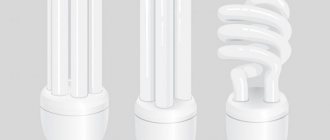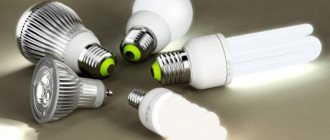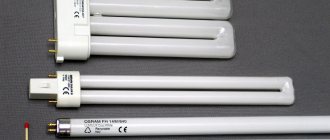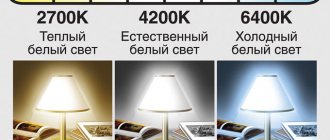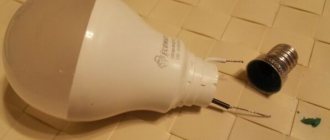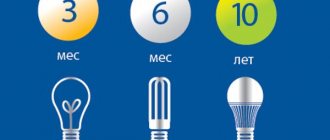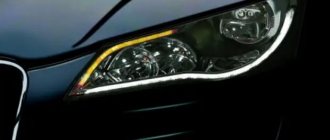LED sources have a lot of advantages, so we can safely assume that in another decade almost every home will have LED lamps installed instead of fluorescent lamps.
If a similar thought has already crept into your head, then hurry to implement it. When comparing two light bulbs of the same power, the diode elements will be significantly ahead of the opponent: they are much brighter and have higher durability.
LED lamps to replace fluorescent lamps
However, the process of switching to LED sources can be painful, since it is not always possible to completely replace the lamp. Therefore, sometimes you have to redo an existing fluorescent one. Fluorescent lamps (the second name is “fluorescent”) can be linear and compact.
Benefits of replacing fluorescent light bulbs with LEDs
Switching to identical LED sources will allow you to achieve energy savings of 2-3 times. Moreover, this is true for any light bulb, regardless of its form factor. Do not forget that modern technologies are constantly improving, and in the case of LED, humanity has not yet reached its maximum heights of development. In the future, such products will be even more effective.
To feel the significant benefits when switching from fluorescent lamps to LEDs, let’s calculate the difference in power for an apartment. Let's say 10 lamps are used, and the average operating time of each is 3 hours per day. Multiply these values with 30 days and get 90 hours per month. Let each lamp consume 50 W/h, which means the monthly consumption is 45 kW. If the cost of 1 kW is 10 rubles, then the payment for electricity when using one such lamp will be 450 rubles.
When switching to LEDs and wanting to keep room illumination at the same level, it is enough to take 20 W LED sources. Thus, 18 kW will be consumed per month for lighting, and the payment for electricity will be 180 rubles. This is 2.5 times less, but in reality this figure can be much higher.
Calculation of the efficiency of replacing fluorescent lamps with LED lamps
The table below shows power indicators for fluorescent and LED lamps with identical luminous flux values.
| Luminescent, W | LED, W | Luminous flux, Lm |
| 5-7 | 2-3 | 250 |
| 10-13 | 4-5 | 400 |
| 15-16 | 6-10 | 700 |
| 18-20 | 10-12 | 900 |
| 25-30 | 12-15 | 1200 |
| 40-50 | 18-20 | 1800 |
| 60-80 | 25-30 | 2500 |
Based on this diagram, it becomes clear that a 36 W fluorescent lamp can be replaced with an 18 W LED lamp. The transition to LED light sources is rational not only economically, but also from an efficiency point of view. To understand the difference, let's list the technical and operational parameters for each light bulb.
Advantages of LED lamps over fluorescent lamps
Luminescent source:
- Service life is approximately 2000 hours. The specific value is directly related to the number of on/off switches, but for this value it should not exceed 2000 cycles.
- Since the light flux is diffuse, that is, it diverges in different directions, the use of reflectors is required to increase illumination.
- After switching on, it takes a few seconds to reach operating brightness.
- Due to the use of a ballast, interference appears in the network.
- Over time, regardless of the number of on/off switches, the protective layer of phosphor degrades, which leads to a decrease in luminous flux by 25-30%.
- There are special requirements for operation and disposal, since the principle of operation is associated with mercury vapor contained in a glass flask.
LED lamp:
- Service life exceeds 10,000 hours regardless of on-off cycles.
- Directional luminous flux, no need for reflectors.
- Instantly reaches operating brightness when the lamp is turned on.
- Instead of a ballast, a driver is used, which eliminates the creation of interference in the network.
- The maximum reduction in brightness due to a longer service life is 10%.
- Reduced energy consumption.
- Environmental friendliness and safety.
The advantage of LED lighting in luminaires
LED lamps are widely installed instead of fluorescent lamps, since, all other things being equal, they are superior in some respects:
- environmental friendliness - fluorescent lamps contain toxic mercury. In this regard, disposal of gas discharges in the usual way is prohibited. The regulations require the delivery of used flasks to a special enterprise, and the cost of disposal starts from 8 rubles per unit. The LED element can simply be thrown into a container for solid household waste; if the structure is destroyed, it does not pose any danger to others;
- light output and performance - although most manufacturers claim the efficiency of LED lamps is 90%. In reality this figure is close to 40%. Taking into account energy losses in the driver, the efficiency of the LED lamp is reduced to 130 lumens per watt, which is 25-30%. However, even taking into account all the deductions, luminescent devices lose here too, since their maximum efficiency does not exceed 80 lumens/Watt - 20%. Considering the lack of developments in this direction, any improvements in gas discharge performance are not expected in the future;
- ergonomics - the operation of fluorescent lamps and ballasts is accompanied by humming, crackling, radio and audio interference for nearby electrical appliances. In addition, the coefficient of light pulsation of gas discharges at the moment of their start exceeds 20% versus 5-10% for LED lamps;
- stability - when voltage surges in the network, especially drops to 180 Volts, fluorescent lamps blink or go out. Cheap Chinese LED devices with a diode bridge instead of a voltage stabilizer also do not work correctly. But the use of high-frequency stabilizers in the circuit solves this problem;
- degradation - the phosphor crumbles and burns out over time, reducing light output and shifting the emission spectrum of the gas discharge into the dangerous ultraviolet range.
The main disadvantage of LED lamps is the price, which is still higher than their gas-discharge counterparts. Increasing accessibility comes through simplifying circuits and using ineffective parts, which eliminates part of the benefit from converting to a new type of lighting instead of outdated fluorescent tubes. Chinese products often work no longer than incandescent lamps, they get very hot and burn out, so their operation becomes even more expensive due to the forced replacement of the light source after it breaks down.
How to convert a fluorescent lamp to LED lamps
It is imperative to remove the starter, which is used as a ballast to turn on the fluorescent lamp. Since the LEDs operate directly from the industrial network, there is no need to use a ballast. Otherwise, you will cause a short circuit when installing the LED. There shouldn’t be any difficulties in terms of dimensions, since you can always find an LED whose dimensions correspond to a fluorescent lamp. This way, you don't have to change the design of the ceiling light. Any adjustments are related solely to the internal electrical circuitry.
To switch to LEDs, just follow these steps:
- Get rid of the starter.
- Close and remove the ballast.
- Disconnect the capacitor.
Connection diagram for T8 LED lamps
Video description
How to replace fluorescent lamps with LED ones.
One lamp usually contains several LEDs. Power is provided using a special circuit - a driver. The design must include a radiator designed to remove excess heat to the outside. The LEDs are located on a long and narrow textolite board. Soldering is not used to connect them. Special gold-plated slots are used to fix the contacts.
Despite the fact that the design of all LED lamps is similar, there are a large number of different lamp designs. By adding special substances to the crystals, the desired shades of the resulting light are achieved. It can be warm or cold.
One of the important tasks of the driver is to convert the input AC voltage to DC. For this, a diode bridge is used, which is located at the input of the circuit. The transparent shell is designed to protect the interior and provide optimal light diffusion.
The principle of operation of a lamp with phosphor Source svetosmotr.ru
LED design
The LED is a small transparent tube made of high-quality plastic. A driver and a getinax strip with soldered LED diodes are placed inside. This is due to the lack of need for external control gear. It is enough to connect the lamp to a 220 V network.
LED products have a standard G13 socket, while inside, using the copper wire of the bulb, a connection is made between the lamp pins. Thanks to this, electricity can be supplied to any pin.
The LED tube can be 600mm or 1500mm long and the power is usually between 9-25W. The light from the source can be warm (yellow) or cool (white). LED lamps come in different forms. The most common are designs with a classic 5 mm case. There is a lens in the upper part, a reflector in the lower part, and a crystal in the body, which is a light emitter (begins to glow when electricity passes through it).
Linear LED lamp design
From an electrical circuit point of view, the LED design is simple. It has two outputs - anode and cathode. The aluminum reflector is placed on the cathode and looks like a cup. The main element of the product is a semiconductor single crystal with a pn junction. When examining this component, you will find a cube whose dimensions are approximately 0.3x0.3x0.25 mm.
The single crystal is connected to the anode through a jumper wire. The body is made of polymer materials, is transparent and, to some extent, represents a focusing lens. Together with the reflector, the housing sets the angle of radiation and the direction of light.
Recommendations for selection
When purchasing an LED lamp, pay attention to its color temperature, which for devices of this class is measured in Kelvin (K). Not only the health status of the person using it, but also the comfort of the lighting received depends on this indicator. It must be indicated in the accompanying documentation for the purchased product or applied directly to the packaging.
Only after becoming familiar with the features of the device and the operation of LL and LED lamps do they undertake the procedure associated with their replacement. Thanks to this, it is possible to avoid unnecessary expenses on the purchase of a new lamp.
Luminaires with electromagnetic ballasts
Older, Soviet fluorescent lamps, in addition to the starter, were equipped with electromagnetic ballasts. In this case, there will be no need to make significant changes. Remove the starter from the device, install an appropriately sized LED and continue to use the product.
There is absolutely no need to remove the throttle. The current consumption will be about 0.15 A, so such a part will act as a jumper. Otherwise, the design of the lamp remains unchanged.
Conversion of a lamp with electronic ballast
In modern fluorescent lamps, the ballasts are electronic. On the other hand, there is no starter inside. In this situation, more significant changes will have to be made to the electrical circuit.
What does a modern fluorescent lighting device look like before converting to an LED lamp:
- throttle;
- wires;
- cartridge pads in two side parts of the body.
Electronic ballast for fluorescent lamps
And here is the first difference: you should immediately remove the inductor, which will lighten the weight of the structure as a whole. Using a screwdriver or pliers, unscrew all fasteners and remove the power supply. A 220 V current source should be connected to the ends of the tube: one end is phase, the other is “zero”.
One of the features of the LED is the rigid connection of the pins on the base, while fluorescent tubes use a standard filament for connection, which ignites mercury vapor.
However, modern devices with electronic ballasts do not have a filament, and a voltage pulse is formed between two contacts. It is difficult to supply 220 V between hard-wired contacts. To ensure that the feed is correct, use a multimeter. Select the resistance measurement mode on it, then touch both contacts to get the desired value. The final value should be equal to or as close as possible to “0”.
Electronic ballast connection diagram
Between the terminals of LED lamps there is a filament with a certain resistance. When voltage is applied, it begins to heat up and the lamp begins to shine. Subsequently, when connecting the LED lamp, use one of two methods:
- without dismantling cartridges;
- with dismantling and installing jumpers between the terminals.
Which lamps are best to choose as replacements?
It is recommended to use a standard principle that has been repeatedly tested by the personal experience of many users. The first recommendation is to choose devices from the range of well-known manufacturers that guarantee high quality products. Such devices are usually expensive, but quickly pay for themselves due to economical energy consumption.
The second selection principle is the number of LED elements per unit area of the working surface of the lamp. The more LED elements placed on the surface, the higher the dissipative ability of the lamp. Therefore, if you need to illuminate a large area of the room, you should choose products with the maximum possible number of LEDs.
This LED lamp, where the placement of working elements is marked in a three-row design, is close to fluorescent devices in terms of light dispersion
Out of habit, a potential buyer chooses light fixtures with an eye to the power parameter. In this case, the power is determined slightly differently - taking into account the ratio of 1 to 10, when compared with a conventional direct incandescent lamp. For example, if the power of a conventional device is 100 W, then the LED analogue will correspond to 10 watts.
It is also important to focus on the color temperature of the lighting fixture. We wrote more about this parameter in the next article.
Based on the operating conditions, lamps are selected according to the protection class. For domestic use, IP40 is usually a satisfactory option. For rooms with higher requirements - protection class 50 and higher. We talked in more detail about the protection class and decoding of values here.
High protection parameters are necessary for luminaires installed in special rooms with an explosive environment.
Without dismantling
This option is easier to implement for several reasons: the connection diagram used does not matter, there is no need to create jumpers, climb into the middle of the cartridge and change the contacts. Get rid of the wires that go to the socket, buy Wago clamps and run them there. The same must be done on the opposite side of the lamp. The phase should flow to one side of the terminal blocks, and “zero” to the other. Instead of clamps, you can use twisted wires and then hide them in PPE caps.
Connecting lamp sockets via Wago terminal blocks
With dismantling the cartridges and installing jumpers
The algorithm for changing the lamp in this case is as follows:
- Remove the side covers of the light fixture.
- Get rid of cartridges with insulated contacts. The socket contains springs suitable for attaching a light bulb.
- Two power wires are connected to the cartridge. They are fixed in contacts and do not have screws. They should be twisted clockwise or counterclockwise. Apply force and remove one wire.
- Since the contacts are insulated, by removing one wire, you ensure that current only flows through one socket. This will not affect the functionality of the lighting fixture in any way, but ideally you should install a jumper to improve it.
- Using a jumper will save you from having to fish out the contact while turning the LED tube.
- A jumper can be created from the remaining power wires from the lamp.
- Having installed the jumper, you need to check the circuit between the insulated parts. The same steps must be done on both sides of the lamp.
- Check where the remaining power wire goes. “Zero” should be applied to it. Tear out the other parts using pliers.
Fluorescent lamps with two or more lamps
When changing a fluorescent fixture with two or more lamps, it is necessary to use different conductors to apply voltage to each terminal. If you install a jumper between the cartridges, the design will have several disadvantages. If you install the first tube in the wrong place, the second one simply will not light up.
Phase, neutral and ground should be connected alternately to the terminal block. Connect the conductors to supply voltage. Before attaching the device to the ceiling, make sure the lamp is working. Apply voltage and adjust the contacts in the absence of light.
Conversion of a fluorescent lamp
The LED light source is directional, but the base has the ability to rotate by 35 degrees, which is useful for adjustment. Cheap Chinese products may not have such a function. Then you will have to move the mounting of the cartridge itself.
Installing multiple lamps
Sometimes several fluorescent lamps were previously used in one place. Although you can choose a bright enough LED to obtain full illumination, sometimes it is better to install the same number of new ones. The following must be taken into account.
Sometimes the connection is provided with one wire on each side. This option is less convenient, since if the first lamp is missing, current will not flow to the subsequent ones. A more reliable solution would be to use separate wires to power each of them.
The three-row arrangement of LEDs creates uniform illumination Source sovet-ingenera.com
Types of lamps
The sockets of LED lamps with pins are designated by the Latin letter G. The following numbers indicate the distance between the central parts of the pins. If there is a numeric value, the second digit indicates the diameter of the circle to which the pins are connected.
For example, a G13 base with a distance of 13 mm can be connected to Armstrong, LPO and LVO lamps. Often, instead of the G13 marking, the T8 designation is used.
LED lamp T8 with g13 socket
Is it always possible to simply screw in an LED lamp instead of a regular one?
No not always.
There are two problems that you may encounter: • Operating a switch that has an indicator. A large number of LED lamps cannot work with switches that have an indicator. They flash or glow dimly when the switch is turned off. This is due to the fact that a weak current constantly flows through the lamp. There are two ways out of this situation: either use lamps that work correctly with such switches or turn off the indicator inside the switch.
• Dimming. Most LED lamps cannot work with dimmers, but there are special dimmable LED lamps (usually much more expensive than regular ones). Unlike incandescent lamps, when the brightness decreases, the LED lamp does not change the color of the illumination (it turns yellow in a conventional lamp). Many dimmable LED lamps are not dimmable to zero, but only to 15-20% of full brightness.
Replacing fluorescent lamps with LED lamps: instructions
Any work on replacing fluorescent lamps with LED lamps must be carried out in compliance with all safety rules. The algorithm looks like this:
- Turn off the circuit breaker. Using a screwdriver with an indicator or a multimeter, make sure there is no voltage.
- Remove the cover from the lamp to reveal the contents.
- Get rid of the capacitor, starter and/or choke.
- Separate the wires connected to the terminals on the socket. Connect them with neutral and phase cables.
- Get rid of or insulate any remaining, unnecessary wiring.
- All that remains is to connect the LED lamp.
Features of the fluorescent lamp device
In order to more clearly understand society’s desire to replace fluorescent lamps with LED devices, it is logical to become more familiar with the gas design.
Indeed, a light device with a luminescent coating is a sealed glass tube, usually filled with mercury vapor.
Fluorescent lamps with lamps filled with a gaseous medium are “powered” by electricity through a choke element. More advanced designs are equipped with an electronic circuit without chokes and are considered somewhat improved in terms of operation
Two modifications of such devices are available:
- For outdoor installation (with high pressure flasks).
- For domestic installation (with low pressure flasks).
In fact, inside the cylinder of a fluorescent lamp there is a mixture of gases consisting of mercury vapor and argon. The inside walls of the glass flask are coated with a special composition - phosphor. When an electric discharge is formed in a gaseous medium, a gas glow is formed, and due to the phosphor, this glow is transformed into light in the visible range.
We wrote more about the design of luminescents in this article.
Advantages of fluorescent lamps
The development and production of lamps of this type, first of all, were the result of a constant request to save energy resources. We should pay tribute - fluorescent lamps allow significant savings.
An energy-saving light device and a traditional source with a direct filament. If we compare the energy parameters, the difference is significant in favor of the first device, where current consumption is reduced significantly
At the same time, you can save due to the higher light output of devices, placing a smaller number of devices per unit area compared to direct incandescent lamps.
The feasibility of using gas-discharge lamps is noted not so much for the domestic sphere, but for industrial and economic structures, that is, where it is necessary to illuminate large areas with minimal costs in terms of energy consumption.
Among the advantages of fluorescent lamps, a decent operating time stands out. The average operating time for gas structures is 10,000 hours.
Comparative cartography, which notes the electrical advantages of light devices of different periods of use. As can be seen from the comparative parameters, the traditional direct-heat lamp is the most “wasteful” light device
If fluorescent lamps are compared to direct filament analogues, where the maximum operating time is 1000 hours, the significant difference becomes more than obvious.
Disadvantages of light devices with phosphor coating
However, the existing advantages of fluorescent lamps, unfortunately, do not hide the obvious disadvantages of these same devices. And the main negative here is the increased chemical hazard.
Structure of the luminescent light source: 1 – sealed glass tube; 2 – phosphor layer; 3 – filament; 4 – luminous flux visible to people; 5 – mercury atom
The cylinder of each lamp contains at least 2 mg of mercury, and this chemical element is classified as extremely dangerous for a living organism. Of course, as long as the flask is sealed, the chemical hazard is reduced to zero.
However, cases of broken glass cylinders of fluorescent lamps are quite common practice. Therefore, it is important to immediately think about the proper disposal of fluorescent lamps.
Also among the disadvantages are the light and the “strobe” effect. Both effects have an adverse effect on vision. That is why fluorescent lamps have not found widespread use in the domestic sphere. In a word, there were every reason to raise the issue of replacing fluorescent lamps. A suitable alternative was quickly found.
Working with the chuck
Since the luminous flux of fluorescent lamps extends in all directions (360 degrees), it does not matter in which direction the source and its socket are directed. However, when switching to LED products characterized by directional light, a situation may occur when the ceiling lamp shines not downwards, but to the side. The simplest solution in such situations may be to use swivel-type bases that can be rotated 90 degrees.
LED lamp with rotating base
Today, the transition to LED light sources is more relevant than ever. Even the cheapest lamps of this type consume at least 50% less electricity, have a longer service life, and are environmentally and electrically safe. If you don't understand basic electrical principles, it will certainly be much easier to purchase a ready-made LED light that will fully pay for itself in just one year.

